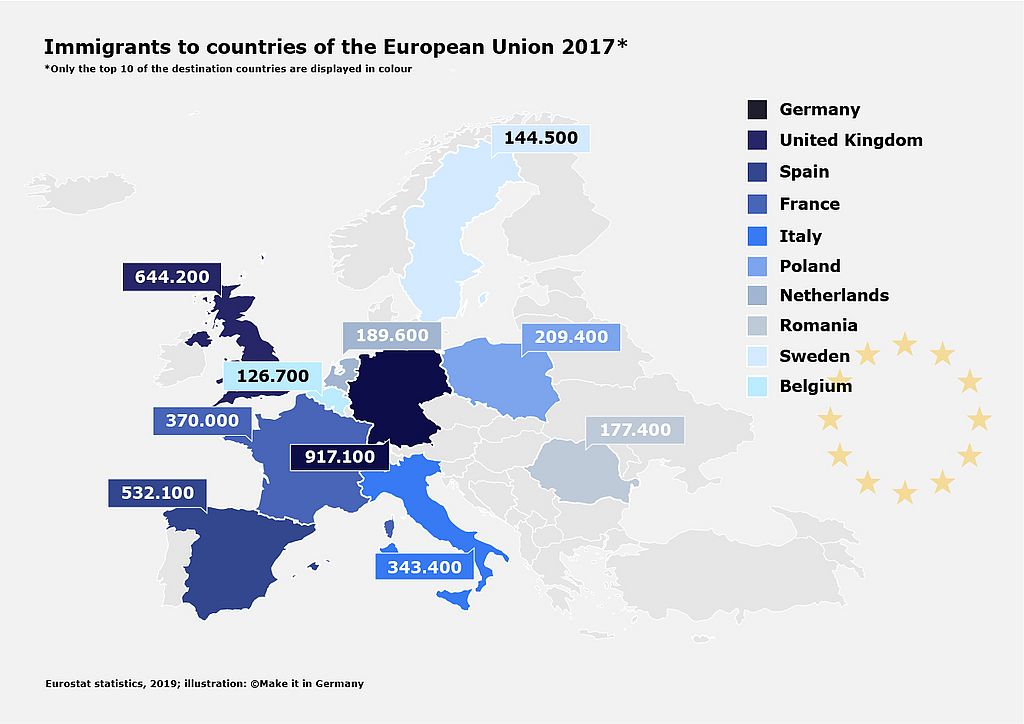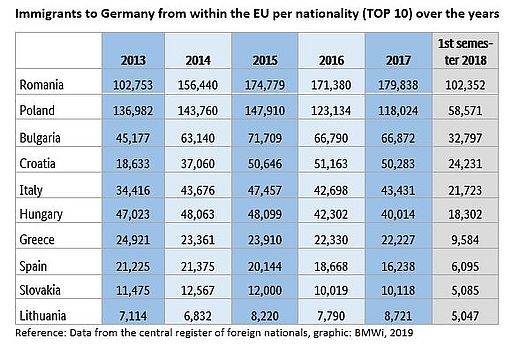Immigration from EU Member States
07 May 2019 - Large numbers of people from other regions of the world would like to live in Germany for many different reasons. The latest data from the central register of foreign nationals (AZR)1 shows that the migration flows to Germany are closely linked to the principle of free movement which applies within the European Union (EU).
Germany is the most popular EU destination for migrants
According to Eurostat estimates, some 4.4 million people migrated to an EU Member State in 2017. During the same period, some 3.1 million people emigrated from an EU country. Germany received the largest number of immigrants (917,000)2. This makes Germany the most popular destination for migrants among the EU Member States. The UK is in second place, followed by Spain and France. The figures include migrants from other EU Member States, people from outside the EU, EU citizens returning to the EU, and stateless persons. The figures on migration within the EU are similar. The Federal Office for Migration and Refugees reports that almost 635,000 EU citizens moved to Germany in 20173. This makes Germany the most popular destination, also for immigrants from other EU Member States.
EU citizens in Germany
At present, Germany is home to around 4.8 million people from other EU countries4. Among them, Polish nationals make up the largest group (881,591), followed by Romanians (670,234), Italians (649,875), Croatians (382,983), and Greeks (364,528).
The most recent developments show that the trend is continuing, with a total of 316,600 non-German EU citizens registering their move to Germany in the first semester of 20185. This figure represents an increase of 3% over the same period in the preceding year. Romanians make up the largest group of immigrants from the EU, with 102,352 people registered. Figure 2/ Table 1 show that they are also the group to have seen the strongest growth in recent years. The second-largest group are people from Poland (58,571 persons), followed by Bulgarians (32,797 persons), Croatians (24,231), and Italians (21,723).
Working in Germany as an EU citizen
Unlike nationals from non-EU member states, EU citizens enjoy freedom of movement. This means that they are free to take up work in Germany without any restrictions (Section 2(2) Freedom of Movement Act/EU).
Under the principle of freedom of movement there are no more border controls at most national borders within the EU. EU citizens do not require a visa to travel to Germany and take up residence in the country. Once they have been in the country for three months, however, they must prove that they are either working or seeking work, or that they have sufficient financial resources in order to be able to afford a living in Germany (e.g. because they receive a pension from another EU Member State). For those who are involuntarily out of work, freedom of movement applies for a period of 6 months, affording EU citizens and their family members leave to remain in Germany (Section 2(3) Freedom of Movement Act/EU).
Support services: The EURES network
The European Employment Services is a network dedicated to the task of promoting freedom of movement in actual practice. The EURES website provides jobseekers from all EU Member States with detailed information about life and work in other EU countries. Employers can also use the website to set up their own profile and advertise their vacancies across Europe. Jobseekers can search the EURES database for jobs in all of the countries of the EEA and/or file their CVs. The EURES network is thus designed to facilitate cross-border application and matching processes on the European labour market.
Sources and notes:
[1] The central register of foreign nationals (AZR) is one of the largest automated registers used by the German public administration. It is a database containing data on foreign nationals living in Germany for a period of move than 90 days.
[2] Reference: Eurostat, March 2019: Migration and migrant population statistics - Statistics Explained (europa.eu)
[3] BAMF (2019): Monitoring freedom of movement – Migration of EU citizens to Germany – Annual Report for 2017: https://www.bamf.de/SharedDocs/Anlagen/EN/Forschung/BerichtsreihenMigrationIntegration/Freizuegigkeitsmonitoring/freizuegigkeitsmonitoring-jahresbericht-2017.html
[4] Current as of 30 June 2018; Reference: central register of foreign nationals (AZR) as cited in: Federal Office for Migration and Refugees, 2019: Monitoring freedom of movement. Migration of EU citizens to Germany – Report for the first semester of 2018, https://www.bamf.de/SharedDocs/Anlagen/EN/Forschung/BerichtsreihenMigrationIntegration/Freizuegigkeitsmonitoring/freizuegigkeitsmonitoring-jahresbericht-2018.html
[5] Statistics taken from the central register of foreign nationals (AZR) as cited in: Federal Office for Migration and Refugees, 2019: Monitoring freedom of movement. Migration of EU citizens to Germany – Report for the first semester of 2018, https://www.bamf.de/SharedDocs/Anlagen/EN/Forschung/BerichtsreihenMigrationIntegration/Freizuegigkeitsmonitoring/freizuegigkeitsmonitoring-jahresbericht-2018.html
Do you have any questions?
Let us advise you on your opportunities to work and live in Germany. Our experts will support you with questions regarding job search, visa, recognition and learning German.
You can find out more about the various contact options by clicking on one of the icons in the bar below.


